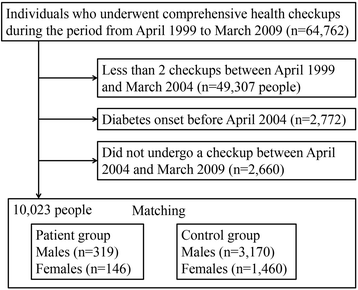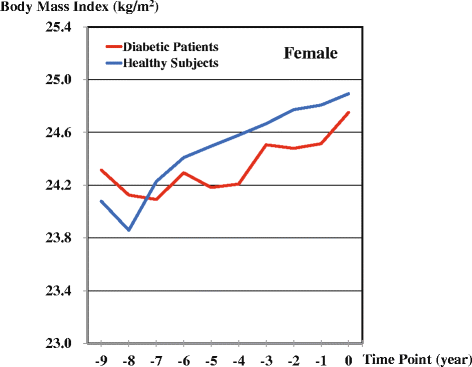Do body mass index trajectories affect the risk of type 2 diabetes? A case-control study
- PMID: 26215867
- PMCID: PMC4517348
- DOI: 10.1186/s12889-015-2073-y
Do body mass index trajectories affect the risk of type 2 diabetes? A case-control study
Abstract
Background: Although obesity is a well-studied risk factor for diabetes, there remains an interest in whether "increasing body mass index (BMI)," "high BMI per se," or both are the actual risk factors for diabetes. The present study aimed to retrospectively compare BMI trajectories of individuals with and without diabetes in a case-control design and to assess whether increasing BMI alone would be a risk factor.
Methods: Using comprehensive health check-up data measured over ten years, we conducted a case-control study and graphically drew the trajectories of BMIs among diabetic patients and healthy subjects, based on coefficients in fitted linear mixed-effects models. Patient group was matched with healthy control group at the onset of diabetes with an optimal matching method in a 1:10 ratio. Simple fixed-effects models assessed the differences in increasing BMIs over 10 years between patient and control groups.
Results: At the time of matching, the mean ages in male patients and controls were 59.3 years [standard deviation (SD) = 9.2] and 57.7 years (SD = 11.2), whereas the mean BMIs were 25.0 kg/m(2) (SD = 3.1) and 25.2 kg/m(2) (SD = 2.9), respectively. In female patients and controls, the mean ages were 61.4 years (SD = 7.9) and 60.1 years (SD = 9.6), whereas the mean BMIs were 24.8 kg/m(2) (SD = 3.5) and 24.9 kg/m(2) (SD = 3.4), respectively. The simple fixed-effects models detected no statistical significance for the differences of increasing BMIs between patient and control groups in males (P = 0.19) and females (P = 0.67). Sudden increases in BMI were observed in both male and female patients when compared with BMIs 1 year prior to diabetes onset.
Conclusions: The present study suggested that the pace of increasing BMIs is similar between Japanese diabetic patients and healthy individuals. The increasing BMI was not detected to independently affect the onset of type 2 diabetes.
Figures
Similar articles
-
Increases in body mass index, even within non-obese levels, raise the risk for Type 2 diabetes mellitus: a follow-up study in a Japanese population.Diabet Med. 2005 Aug;22(8):1107-11. doi: 10.1111/j.1464-5491.2005.01602.x. Diabet Med. 2005. PMID: 16026381
-
The Association Between Body Mass Index and All-Cause Mortality in Patients With Type 2 Diabetes Mellitus: A 5.5-Year Prospective Analysis.Medicine (Baltimore). 2015 Aug;94(34):e1398. doi: 10.1097/MD.0000000000001398. Medicine (Baltimore). 2015. PMID: 26313785 Free PMC article.
-
Independent impact of body mass index and metabolic syndrome on the risk of type 2 diabetes in Koreans.Metab Syndr Relat Disord. 2012 Oct;10(5):321-5. doi: 10.1089/met.2011.0143. Epub 2012 May 23. Metab Syndr Relat Disord. 2012. PMID: 22621338
-
Age- and gender-specific BMI in terms of the lowest mortality in Japanese general population.Obesity (Silver Spring). 2008 Oct;16(10):2348-55. doi: 10.1038/oby.2008.342. Epub 2008 Jul 24. Obesity (Silver Spring). 2008. PMID: 18719651
-
Risks of Myocardial Infarction, Death, and Diabetes in Identical Twin Pairs With Different Body Mass Indexes.JAMA Intern Med. 2016 Oct 1;176(10):1522-1529. doi: 10.1001/jamainternmed.2016.4104. JAMA Intern Med. 2016. PMID: 27479111
Cited by
-
Trajectories of childhood BMI and adult diabetes: the Bogalusa Heart Study.Diabetologia. 2019 Jan;62(1):70-77. doi: 10.1007/s00125-018-4753-5. Epub 2018 Oct 20. Diabetologia. 2019. PMID: 30343393 Free PMC article.
-
Age of obesity onset, cumulative obesity exposure over early adulthood and risk of type 2 diabetes.Diabetologia. 2020 Mar;63(3):519-527. doi: 10.1007/s00125-019-05058-7. Epub 2019 Dec 20. Diabetologia. 2020. PMID: 31858184
-
Body mass index trajectory patterns and changes in visceral fat and glucose metabolism before the onset of type 2 diabetes.Sci Rep. 2017 Mar 7;7:43521. doi: 10.1038/srep43521. Sci Rep. 2017. PMID: 28266592 Free PMC article.
-
How do sex-specific BMI trajectories shape diabetes risk? A longitudinal analysis of Indonesian adults.BMJ Public Health. 2023 Nov 6;1(1):e000020. doi: 10.1136/bmjph-2023-000020. eCollection 2023 Nov. BMJ Public Health. 2023. PMID: 40017894 Free PMC article.
-
BMI trajectory and subsequent risk of type 2 diabetes among middle-aged women.Nutr Metab Cardiovasc Dis. 2021 Apr 9;31(4):1063-1070. doi: 10.1016/j.numecd.2020.12.019. Epub 2020 Dec 26. Nutr Metab Cardiovasc Dis. 2021. PMID: 33612383 Free PMC article.
References
-
- International Diabetes Federation. Diabetes Atlas 6th Edition. 2013. Available: http://www.idf.org/diabetesatlas. Accessed 29 June 2015.
-
- Headquarters of Cancer Control, Ministry of Health, Labour and Welfare . Outline of the results of the 2012 National Health and Nutrition Survey. 2013.
MeSH terms
LinkOut - more resources
Full Text Sources
Other Literature Sources
Medical




